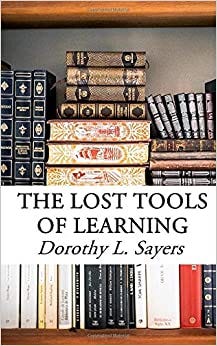Text #1: The Lost Tools of Learning
Dorothy Sayers's Speech and its Influence on CCE
In 1947, Dorothy Sayers1, a British writer, essayist, playwright, poet, and professor gave a speech at Oxford entitled The Lost Tools of Learning.2 Within it, she laid out the pattern for classical learning later used by Douglas Wilson in the late 1970’s when forming The Logos School. Like Wilson, whose book3 will be the subject of a later post, parents desiring a classical education for their children can look to Sayers’ speech as a starting point in understanding what classical education looks like.
Sayers notes that schools may do a good job teaching subjects (i.e., math, English, science, art, world language) but they do not do well teaching children how to use the tools they need to learn. A carpenter cannot build a table without a saw, a plane, a hammer, and a level. It goes to reason that a student cannot adequately learn without the right tools, and according to Sayers, the right tools hearken back to and are influenced by the classical method of educating young boys in the Middle Ages.
The tools make up the Trivium, which is Latin for “the place where three roads
meet.” 4 In an educational context, the Trivium is comprised of Grammar, Logic (Dialectic), and Rhetoric. Its specific purpose is to teach the tools of learning first followed by applying them to different subjects (D. Sayers, 1948).
The three distinct parts of the Trivium, according to Sayers, correlate to three stages of a child’s development: the Poll-Parrot, Pert, and Poetic Ages. Grammar can be a subject in relation to language, as noted by Sayers, but in this particular context it is what I akin to foundational knowledge—you must know your ABC’s before you can create sounds and words.
In the Poll-Parrot Age (Grammar), children are building their semantic memory5 , the place for storing our knowledge of words, facts, numbers that will be permanent. I look to my two granddaughters, one and two years old, as examples of this stage. They will repeat frequently what they hear (Poll-Parrot) whether I want them to or not! In this stage of their brain’s development, they are placing this knowledge into their permanent memory bank but are not ready to put it to use. In classic schools, recitation is a common strategy used to help kindergarten and elementary-school-age children memorize large quantities of information that they will begin utilizing in later stages of the Trivium.
The Pert Age happens around nine or ten when children begin to talk back to authority figures such as parents or teachers and ask questions, especially “Why?” I entered this stage around the age of seven. I can remember my parents responding, “Because I told you so,” when they were tired of hearing my questions! This stage of development fuels the second part of the Trivium, that of logic, where students ask questions to better understand data they know.
The final stage of the Trivium is the Poetic Age. When I taught tenth grade English, I equated rhetoric to persuasion and required my students to read texts and find evidence of rhetoric (i.e., parallelism, rhetorical questions, logical appeals). Students in upper middle to early high school years should be ready to begin synthesizing the data they’ve learned to that point, making arguments, forming opinions, and supporting them with evidence. About the Poetic Age, Sayers says, “the imagination—usually dormant during the Pert Age—will reawaken” and students must be given freedom to explore any “sudden insight” (1948). In this stage, a student may begin to develop a passion for a subject and pursue it for the sake of learning rather than for a course requirement.
Sayers speech has much more to offer regarding classical education, including a push for learning Latin in the early stages of the Trivium. She also gives detailed explanations of how each of the stages of the Trivium look when studying academic subjects and how students’ thoughts deepen as they proceed through the stages. She also mentions the final thesis, or how the Trivium concludes. The Trivium is not the end of a student’s education; Those who desire may pursue the Quadrivium, the extension of a liberal arts education into the mathematical arts (Cleary, n.d.).6
Teachers in modern classrooms frequently bemoan the fact that students do not know how to think critically. On the surface, the tools of learning Sayers promotes make classical education extremely appealing and a possible solution to this problem. Proponents promote critical thinking as a result of classical education. Stay tuned as I continue to immerse myself in this new (old) educational method and formulate my own opinion.
Sayers was born in Britain in the last decade of the 1800’s and became known for writing the Lord Peter Whimsey mystery series. She was an intellectual educated in the early 20th century at Oxford. She frequently corresponded with C.S. Lewis and was friends with other famous authors such as T.S. Eliot. While known for her writing, she also was a notable translator of Dante’s The Divine Comedy.
Dorothy, S. (1948). The Lost Tools of Learning [Journal article]. Vacation Course in Education. LostToolsOfLearning-DorothySayers.pdf (pccs.org)
Wilson, D. (2022). Recovering the Lost Tools of Learning: An Approach to Distinctively Christian Education (2nd ed.). Canon Press. Kindle eBook
Classical Conversations. (2022, October 31). What is the trivium: An easy-to-understand analogy. Classical Conversations: Classical Christian Community. https://classicalconversations.com/blog/what-is-the-trivium/
NOBA: The Noba Project. (2023). Psychology (Noba) (pp. 5.3.1–5.3.17). Department of Education Open Textbook Pilot Project. https://socialsci.libretexts.org/Bookshelves/Psychology/Book%3A_Psychology_(Noba)/Chapter_5%3A_Learning_and_Memory/5.3%3A_Memory_(Encoding_Storage_Retrieval) CC BY-NC-SA 4.0
Cleary, F. (n.d.). Understanding the Trivium and the Quadrivium. Student Stories Blog. Retrieved March 10, 2023, from https://www.hillsdale.edu/hillsdale-blog/academics/understanding-trivium-quadrivium/


